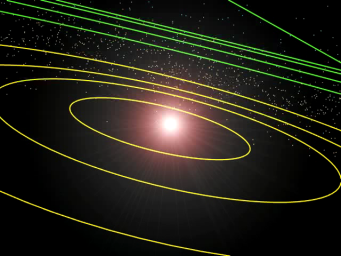Sedna Orbit Animation
Caption:
View the animation
.
This animation shows the location of the newly discovered planet-like object, dubbed "Sedna," in relation to the rest of the solar system. Starting at the inner solar system, which includes the orbits of Mercury, Venus, Earth, and Mars (all in yellow), the view pulls away through the asteroid belt and the orbits of the outer planets beyond (green). Pluto and the distant Kuiper Belt objects are seen next until finally Sedna comes into view. As the field widens the full orbit of Sedna can be seen along with its current location. Sedna is nearing its closest approach to the Sun; its 10,000 year orbit typically takes it to far greater distances. Moving past Sedna, what was previously thought to be the inner edge of the Oort cloud appears. The Oort cloud is a spherical distribution of cold, icy bodies lying at the limits of the Sun's gravitational pull. Sedna's presence suggests that this Oort cloud is much closer than scientists believed.
Cataloging Keywords:
| Name |
Value |
Additional Values |
| Target |
90377 Sedna |
|
| System |
Kuiper Belt |
|
| Target Type |
KBO |
Dwarf Planet |
| Mission |
Palomar Observatory |
|
| Instrument Host |
Palomar Observatory |
|
| Host Type |
Ground-Based Telescope |
|
| Instrument |
Samuel Oschin Telescope |
|
| Detector |
|
|
| Extra Keywords |
Color, Movie |
| Acquisition Date |
|
| Release Date |
2004-03-15 |
| Date in Caption |
|
|
| Image Credit |
NASA/JPL-Caltech |
| Source |
photojournal.jpl.nasa.gov/catalog/PIA05565 |
| Identifier |
PIA05565 |

 Movie Download Options
Movie Download Options